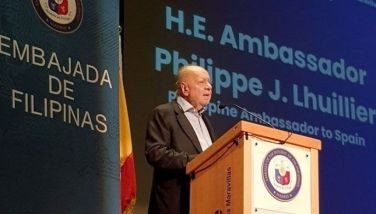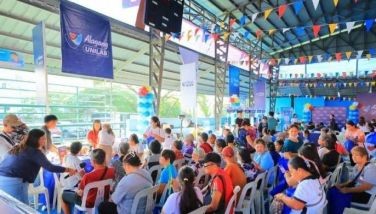6 Guadalupe wells not safe
CEBU, Philippines - After a series of tests, the Cebu City Health Department found that six of nine water sources tested in Barangay Guadalupe were not safe for drinking due to the presence of fecal coliform bacteria.
Regional Epidemiology and Surveillance Unit chief epidemiologist Rennan Cimafranca said he has yet to verify if this covers the water refilling service provider in the community where suspected patients of typhoid fever come from.
“According to verbal results as relayed by city health officials, 6 of the 9 samples tested positive for fecal coliform. This is considered to be one of the possible reasons why the people in Sitio Tugasan got sick. We are likely to rule out food-related factor since the common thing among these people is the source of water,” Cimafranca said.
The presence of fecal coliform bacteria in aquatic environments or ambient water indicates that the water has been contaminated with the fecal material of domestic sewage or nonpoint sources of human and animal waste.
The source water may have been contaminated by pathogens or disease producing bacteria or viruses which can also exist in fecal material, causing typhoid fever, viral and bacterial gastroenteritis and Hepatitis A.
Deep wells
A water distribution system owned by Candido dela Cerna in Sitio Sandayong was among the six sources contaminated with pathogens.
“Di ko moingon nga 100-percent safe ang water gumikan sa nagklase-klaseng hugaw dala sa kakuwangan og kasilyas. Apan wa man ta magpasagad kay duna man tay precautionary measures like pag-apply og chlorine sa tubig,” he said.
The business has supplied water to more than 30 households in lower and upper Sitio Sandayong since the 1980s from a 250-foot deep well.
In a test conducted by the Water Quality Division of Metropolitan Cebu Water District yesterday, it was found out that the water supplied by Dela Cerna exceeded the normal chlorine content in water.
Water Quality Division manager Helen Aragones said the water has 3.4 parts per million of chlorine, more than the allowed 1.5ppm for drinking, as required by the Department of Health.
“One to 1.5ppm nga residual chlorine pero nanobra iyaha (Dela Cerna) basi’g tungod sa atong inspection gipakusgan ang dosage (of chlorine),” she said.
She pointed out, though, that there are minimal health hazards of the doubled dosage of chlorine.
“Dili man gyod siya maka-affect og grabe sa health. Ang disadvantage lang kay masimhot nimo ang kaisog sa baho sa chlorine nga dili tolerable,” she said.
Dela Cerna said he is treating the water with 100 grams of chlorine powder a day to kill bacteria and other microbes in water. He pays MCWD P1 a month as a water levy to MCWD, serves as tax utilization.
Another water source managed by Rudy Haya was also found positive of fecal coliform. The water is sourced from a spring near a lake in the area and is contained in a six-cubic-meter detention pond that supplies 50 to 60 households in Sitio Sandayong, only for purposes of bathing and washing clothes.
Haya said his source can produce 10 barrels of water or two cubic meters of water per hour, and is sold for P20 per barrel. He added that one kilo of chlorine powder is applied in the detention pond twice a year.
“Ang mga nanga-igo og typhoid dili gyod to namo consumidor, mao di mi sad-an,” he insists.
Nitrate content
Apart from chlorine testing, MCWD will be conducting a chemical physical test on nitrate content, as Guadalupe is naturally high in nitrates, which may pose risks to infants and pregnant women.
“Ang Guadalupe known ni siya nga taas og nitrate that’s why nagkuha ta’g samples to test how high is the presence of nitrate kay maka-cause siya og Methemoglobinemia or blue baby,” she said.
Based on the standards of the Philippine National Standards for Drinking Water, the presence of nitrate in drinking water must be 50 milligrams per liter.
According to Aragones, there are 13 parameters set by PNSDW to know if the water is safe for drinking. These are tests for nitrates, sulphates, chloride, turbidity, total dissolved solids, total solids, heavy metals (lead, chromium, cadmium) among others.
CHD chief Dr. Daisy Villa said they collected more water samples yesterday for testing to supplement the recent test. However, it would take a longer process to determine concretely the pathogens present in the water.
Aside from passing safety tests, water suppliers are required to submit necessary documents like business permit, sanitary permit, among others, to be able to sell potable water.
“If the water distributors would not be submitting the required documents, it will be a concrete ground for closure,” she said.
Cimafranca suspected that the community uses a mixed water source: from refilling station and the wells.
“We recommended to the city and barangay officials to have 100 percent sanitary toilets in the area, to improve the water source and not just rely on private operators which are not even holding proper permits especially sanitary permit,” he said.
Only 30 percent of households in Sitio Tugasan have sanitary toilets, a concern to health authorities as this may lead to water source contamination.
Cimafranca clarified that they are not aiming to shut the private water supplier down but rather temporarily suspend them should they be proven to have violated standards set by the government.
“We will enforce what is required like employing chlorinators, regular testing of water quality, among others,” he added.
Cimafranca said the Cebu City Health Office is in the forefront of addressing the situation, seeing no need for the regional office to take the lead.
“The city health can handle the situation. We are here to assist them. We don’t think our full intervention is needed. This is not an outbreak. The cases are just clustered or grouped and has been immediately addressed,” he said, adding that they fear cholera more than typhoid.
Water-borne cholera causes diarrhea and severe dehydration which could lead to death while typhoid is milder whose classic symptom is fever and is not fatal.
Nine patients from the same community have been brought to the Vicente Sotto Memorial Medical Center; five were admitted while the rest were sent home.
Sampling has been done on these patients for typhoid confirmatory laboratory test, while six more rectal swab samples were obtained from people with direct contact to the nine typhoid suspect patients.
MCWD spokeswoman Charmaine Rodriguez-Kara said they are ready to prioritize the affected sitios of the said barangay in the water distribution, if the need arises. /BRP (FREEMAN)
- Latest






















